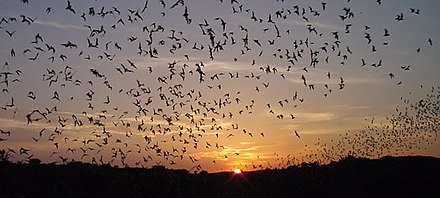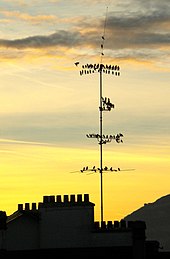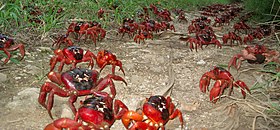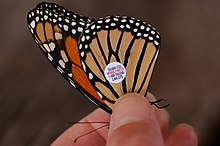Animal migration

Animal migration is the relatively long-distance movement of individual
To be counted as a true migration, and not just a local dispersal or irruption, the movement of the animals should be an annual or seasonal occurrence, or a major habitat change as part of their life. An annual event could include Northern Hemisphere birds migrating south for the winter, or wildebeest migrating annually for seasonal grazing. A major habitat change could include young Atlantic salmon or sea lamprey leaving the river of their birth when they have reached a few inches in size. Some traditional forms of human migration fit this pattern.
Migrations can be studied using traditional identification tags such as bird rings, or tracked directly with electronic tracking devices. Before animal migration was understood, folklore explanations were formulated for the appearance and disappearance of some species, such as that barnacle geese grew from goose barnacles.
Overview
Concepts

Migration can take very different forms in different species, and has a variety of causes.[1][2][3] As such, there is no simple accepted definition of migration.[4] One of the most commonly used definitions, proposed by the zoologist J. S. Kennedy[5] is
Migratory behavior is persistent and straightened-out movement effected by the animal's own locomotory exertions or by its active embarkation on a vehicle. It depends on some temporary inhibition of station-keeping responses, but promotes their eventual disinhibition and recurrence.[5]
Migration encompasses four related concepts: persistent straight movement; relocation of an individual on a greater scale (in both space and time) than its normal daily activities; seasonal to-and-fro movement of a population between two areas; and movement leading to the redistribution of individuals within a population.[4] Migration can be either obligate, meaning individuals must migrate, or facultative, meaning individuals can "choose" to migrate or not. Within a migratory species or even within a single population, often not all individuals migrate. Complete migration is when all individuals migrate, partial migration is when some individuals migrate while others do not, and differential migration is when the difference between migratory and non-migratory individuals is based on discernible characteristics like age or sex.[4] Irregular (non-cyclical) migrations such as irruptions can occur under pressure of famine, overpopulation of a locality, or some more obscure influence.[6]
Seasonal
Seasonal migration is the movement of various species from one habitat to another during the year. Resource availability changes depending on seasonal fluctuations, which influence migration patterns. Some species such as Pacific salmon migrate to reproduce; every year, they swim upstream to mate and then return to the ocean.[7] Temperature is a driving factor of migration that is dependent on the time of year. Many species, especially birds, migrate to warmer locations during the winter to escape poor environmental conditions.[8]
Circadian
Circadian migration is where birds utilise circadian rhythm (CR) to regulate migration in both fall and spring. In circadian migration, clocks of both circadian (daily) and circannual (annual) patterns are used to determine the birds' orientation in both time and space as they migrate from one destination to the next. This type of migration is advantageous in birds that, during the winter, remain close to the equator, and also allows the monitoring of the auditory and spatial memory of the bird's brain to remember an optimal site of migration. These birds also have timing mechanisms that provide them with the distance to their destination.[9]
Tidal
Tidal migration is the use of tides by organisms to move periodically from one habitat to another. This type of migration is often used in order to find food or mates. Tides can carry organisms horizontally and vertically for as little as a few nanometres to even thousands of kilometres.[10] The most common form of tidal migration is to and from the intertidal zone during daily tidal cycles.[10] These zones are often populated by many different species and are rich in nutrients. Organisms like crabs, nematodes, and small fish move in and out of these areas as the tides rise and fall, typically about every twelve hours. The cycle movements are associated with foraging of marine and bird species. Typically, during low tide, smaller or younger species will emerge to forage because they can survive in the shallower water and have less chance of being preyed upon. During high tide, larger species can be found due to the deeper water and nutrient upwelling from the tidal movements. Tidal migration is often facilitated by ocean currents.[11][12][13]
Diel :=
While most migratory movements occur on an annual cycle, some daily movements are also described as migration. Many aquatic animals make a diel vertical migration, travelling a few hundred metres up and down the water column,[14] while some jellyfish make daily horizontal migrations of a few hundred metres.[15]
In specific groups
Different kinds of animals migrate in different ways.
In birds

Approximately 1,800 of the world's 10,000 bird species migrate long distances each year in response to the seasons.[16] Many of these migrations are north-south, with species feeding and breeding in high northern latitudes in the summer and moving some hundreds of kilometres south for the winter.[17] Some species extend this strategy to migrate annually between the Northern and Southern Hemispheres. The Arctic tern has the longest migration journey of any bird: it flies from its Arctic breeding grounds to the Antarctic and back again each year, a distance of at least 19,000 km (12,000 mi), giving it two summers every year.[18]
Bird migration is controlled primarily by day length, signalled by hormonal changes in the bird's body.[19] On migration, birds navigate using multiple senses. Many birds use a sun compass, requiring them to compensate for the sun's changing position with time of day.[20] Navigation involves the ability to detect magnetic fields.[21]
In fish

Most fish species are relatively limited in their movements, remaining in a single geographical area and making short migrations to overwinter, to spawn, or to feed. A few hundred species migrate long distances, in some cases of thousands of kilometres. About 120 species of fish, including several species of salmon, migrate between saltwater and freshwater (they are 'diadromous').[22][23]
In the '
In insects
Some winged
In some
In mammals
Some mammals undertake exceptional migrations; reindeer have one of the longest terrestrial migrations on the planet, reaching as much as 4,868 kilometres (3,025 mi) per year in North America. However, over the course of a year, grey wolves move the most. One grey wolf covered a total cumulative annual distance of 7,247 kilometres (4,503 mi).[29]

Mass migration occurs in mammals such as the
Humans are mammals, but human migration, as commonly defined, is when individuals often permanently change where they live, which does not fit the patterns described here. An exception is some traditional migratory patterns such as transhumance, in which herders and their animals move seasonally between mountains and valleys, and the seasonal movements of nomads.[36][37]
In other animals
Among the reptiles, adult sea turtles migrate long distances to breed, as do some amphibians. Hatchling sea turtles, too, emerge from underground nests, crawl down to the water, and swim offshore to reach the open sea.[38] Juvenile green sea turtles make use of Earth's magnetic field to navigate.[39]

Some crustaceans migrate, such as the largely-terrestrial Christmas Island red crab, which moves en masse each year by the millions. Like other crabs, they breathe using gills, which must remain wet, so they avoid direct sunlight, digging burrows to shelter from the sun. They mate on land near their burrows. The females incubate their eggs in their abdominal brood pouches for two weeks. Then they return to the sea to release their eggs at high tide in the moon's last quarter. The larvae spend a few weeks at sea and then return to land.[40][41]
Tracking migration

Scientists gather observations of animal migration by tracking their movements. Animals were traditionally tracked with identification tags such as
Radio-tracking tags can be fitted to insects, including
In culture
Before animal migration was understood, various folklore and erroneous explanations were formulated to account for the disappearance or sudden arrival of birds in an area. In
See also
References
- ISBN 978-0-00-219940-7.
- S2CID 16752713.
- ^ National Geographic. Why Animals Migrate Archived 28 July 2011 at the Wayback Machine
- ^ S2CID 196608896.
- ^ a b Kennedy, J. S. (1985). "Migration: Behavioral and ecological". In Rankin, M. (ed.). Migration: Mechanisms and Adaptive Significance: Contributions in Marine Science. Marine Science Institute. pp. 5–26.
- ^ Ingersoll, Ernest (1920). . In Rines, George Edwin (ed.). Encyclopedia Americana.
- ^ "About Pacific Salmon". Pacific Salmon Commission. 12 February 2015. Retrieved 30 April 2020.
- ^ "The Basics of Bird Migration: How, Why, and Where". All About Birds. 1 January 2007. Retrieved 30 April 2020.
- PMID 9317295.
- ^ S2CID 11320839.
- .
- doi:10.1111/j.1095-8649.2007.01313.x.)
{{cite journal}}: CS1 maint: multiple names: authors list (link - S2CID 11320839.
- S2CID 83760473.
- .
- S2CID 744140.
- ISBN 978-0-19-850787-1.
- ISBN 978-0-19-857507-8.
- PMID 19324648.
- ^ Lockley, Ronald M. (1967). Animal Navigation. Pan Books. p. 136.
- PMID 17895978.
- ^ Harden Jones, F. R. Fish Migration: strategy and tactics. pp139–166 in Aidley, 1981.
- JSTOR 1438482.
- .
- S2CID 84513261. Archived from the originalon 20 April 2012.
- .
- ^ Tipping, Christopher (8 May 1995). "Chapter 11: The Longest Migration". Book of Insect Records. Department of Entomology & Nematology University of Florida. Archived from the original on 24 September 2015.
- ISSN 0906-7590.
- PMID 31654045.
- ^ "How to Get There, Ngorongoro Crater". Ngorongoro Crater Tanzania. 2013. Archived from the original on 22 March 2014. Retrieved 19 June 2014.
- United Nations Educational, Scientific and Cultural Organization – World Heritage Centre. Archivedfrom the original on 12 June 2014. Retrieved 19 June 2014.
- doi:10.3354/esr00173.
- ^ van Oosterzee, Penny (9 December 2017). "Wildebeest no more: The death of Africa's great migrations". New Scientist. Cites Harris et al. See figure.
- ^ "Bats & Migration". Organization for Bat Conservation. Archived from the original on 14 June 2014. Retrieved 19 June 2014.
- ^ Lockyer, C. H. and Brown, S. G. The Migration of Whales. pp. 105–137 in Aidley 1981.
- ^ Baldridge, Elizabeth (27 August 2020). "Migration vs. Immigration: Understanding the Nuances". The Word Point. Retrieved 1 October 2021.
- ISSN 1022-0119.
- ISBN 978-3-540-26603-7.
- S2CID 4329507.
- ^ "Red Crabs". Parks Australia. 2013. Archived from the original on 3 July 2014. Retrieved 19 June 2014.
- S2CID 28150487.
- ^ a b "What is animal tracking?". Movebank: For Animal Tracking Data. Archived from the original on 21 April 2014.
- S2CID 34444695.
- S2CID 8073226.
- ^ "Tracking Migration of Dragonflies, Sparrows, and Bees". National Geographic. Archived from the original on 30 May 2014.
- ^ "The Earthlife Web – What is Bird Migration". Archived from the original on 25 September 2009.
- ^ "Medieval Bestiary – Barnacle Goose". Archived from the original on 25 November 2016.
- ISBN 978-0-7011-6907-7.
Further reading
General
- Aidley, D. J. (1981). Animal migration. ISBN 978-0-52123-274-6.
- Baker, R. R. (1978) The Evolutionary Ecology of Animal Migration. Holmes & Meier. ISBN 978-0-34019-409-6.
- Dingle, H. (1996) Migration: The Biology of Life on the Move. ISBN 978-0-19802-577-1.
- Gauthreaux, S. A. (1980) Animal Migration, Orientation, and Navigation. ISBN 978-0-12277-750-9.
- Milner-Gulland, E. J., Fryxell, J. M., and Sinclair, A. R. E. (2011) Animal Migration: A Synthesis. ISBN 978-0-19956-899-4.
- Rankin, M. (1985) Migration: Mechanisms and Adaptive Significance: Contributions in Marine Science. OCLC 747358527.
- Riede, K. (2002) Global Register of Migratory Species. With database and GIS maps on CD. ISBN 978-3-78433-826-2.
By group
- Drake, V. A. and Gatehouse, A. G. (1995) Insect migration: tracking resources through space and time. ISBN 978-0-52101-853-1
- Elphick, J. (1995) The atlas of bird migration: tracing the great journeys of the world's birds. ISBN 978-1-55407-971-1
- Greenberg, R. and Marra, P. P. (2005) Birds of Two Worlds: The Ecology and Evolution of Migration. ISBN 978-0-80188-107-7
- Lucas, M. C. and Baras, E. (2001) Migration of freshwater fishes. ISBN 978-0-47099-964-6
- MacKeown, B. A. (1984) Fish migration. ISBN 978-0-91730-499-6
- Sonnenschein, E; Berthold, P. (2003) Avian migration. ISBN 978-3-54043-408-5
For children
- Gans, R. and Mirocha, P. How do Birds Find their Way? ISBN 978-0-43969-940-2
- Marsh, L. (2010) Amazing Animal Journeys. ISBN 978-0-00826-686-8
External links
- Migration Basics from U.S. National Park Service
- Witnessing the Great Migration in Serengeti and Masai Mara
- Global Register of Migratory Species – identifies, maps and features 4,300 migratory vertebrate species
- Animal migration on PubMed MeSH term F01.145.113.083

